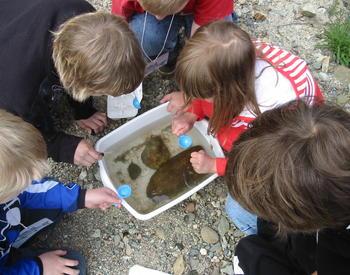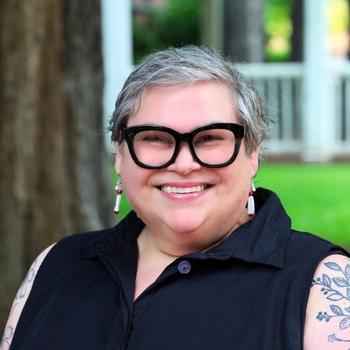OSU Extension partnership opens traditionally closed door to Tribal students
CORVALLIS, Ore. – During Hunter Grove’s internship at Oregon State University’s Hatfield Marine Science Center, she realized that she couldn’t be a marine scientist.
“I get seasick,” Grove admitted. “I don't like boats.”
While some may see that as a failure, it is one of the many successful outcomes of the New Beginnings for Tribal Students program launched four years ago through a collaboration of the Oregon State University Extension Service, Southwestern Oregon Community College (SOCC), and Confederated Tribes of Coos, Lower Umpqua and Siuslaw Indians (CTCUSI).
Seasickness aside, Grove, who uses she and they pronouns, gained confidence, connections and further clarity about their pathway as an Indigenous student pursing science. They developed connections with lifelong mentors and learned about grant funding for additional research.
Also, “some of my friends came from my internship,” Grove said.
OSU’s New Beginnings for Tribal Students (NBTS) program includes support for Indigenous OSU and SOCC undergraduates pursing STEM internships, including an additional stipend and mentorship, and a pre-college summer camp at OSU to give Tribal high schoolers an opportunity to learn about accessing higher education and careers in natural resources.
The Confederated Tribes of Coos, Lower Umpqua and Siuslaw Indians also host their own internship program for Tribal high schoolers to gain professional skills in the Tribe’s various departments through a School to Work program revitalized with support from NBTS.
The NBTS program is supported by a grant from the U.S. Department of Agriculture’s National Institute of Food and Agriculture through an initiative that aims to support Tribal students on their path to higher education at land grant universities.
The initiative fills a gap. In the United States, only 15% of Native Americans hold a college degree — less than half the national average. That is reflected in the OSU student population, which is made up of only 0.5% Indigenous undergraduates.
Acknowledging history
Indigenous communities have a long history of exclusion from higher education and STEM fields, despite their direct contributions and losses.
A 2020 investigation from High Country News found that “The United States took nearly 11 million acres of land from approximately 250 tribes, bands and communities … to fund land grant universities.”
Bessie Joyce, who manages the NBTS program at OSU, said the university qualifies for the USDA-NIFA grant program because it’s a land grant university that benefited from land taken from people who have lived here for thousands of years.
The NBTS partnership with the community college and Tribe is one of several programs OSU has launched over the last several years to repair that violation, Joyce said. Another initiative included waiving tuition for Tribal students. “NBTS specifically is aimed at opening up opportunities to help Native students be more successful and find support in their college experience and in their careers,” said Joyce.
There is a unique exclusion in the STEM fields the program is working to combat. In many ways, Western science is behind Indigenous science and knowledge practices, yet that is rarely the narrative, according to Chance White Eyes, director of Tribal relations at Oregon State and member of the Oneida Tribe of Wisconsin.
Grove, who is from the Karuk Tribe, agreed. She referred to a story about bears central to some Indigenous teaching. The story explains how two bears went from having long tails to short stubby ones. “It’s the story of evolution,” Grove said, pointing out that Indigenous storytelling captured the phenomenon millennia before Darwin theorized it.
Bridging the gap
Building connections and providing direct resources are two important ways to bridge the STEM gap, said Angie Morrill, OSU Extension’s director of Native American and Tribal programs and an enrolled member of the Klamath Tribes.
Being able to get enough funding was vital for Grove to do the internship. “The additional stipend helped me financially because I'm a self-sustaining student. I have all my own bills to pay. I really appreciated the program for that reason,” said Grove.
NBTS students at OSU receive between $2,000 and $4,500 for a full summer internship. SOCC provides $1,000 and access to a laptop for their students pursing shorter career exploration experiences. SOCC has also launched an emergency fund for Native students in need of immediate resources.
The Cooperative Institute for Marine Ecosystem and Resources Studies (CIMERS) has partnered with NBTS to add additional support for Native students in marine studies programs. Grove received one of these grants.
Programs like NBTS, where mentorship with faculty is built in, empowers Tribal students to build those connections, Morrill said.
“Academia is so hierarchical,” Morrill said. “It can be really culturally difficult to navigate. The sooner you can get comfortable asking professors for their support the better off you're going to be.”
That is also a reason why another core component of NBTS is providing training for OSU faculty to better support Tribal students. NBTS webinars have brought in over 300 attendants.
The pre-college camp, which occurs in August on the OSU campus in Corvallis, will introduce students to the school. They will stay in the dorms, use the dining halls and learn in classrooms so they can imagine themselves on campus as students.
At the same time, OSU will make it engaging with field trips and non-academic activities. “These are kids. They need time to have fun,” said Morrill.
Morrill, who joined OSU Extension in December, added a couple other key changes for this year’s camp. While the camp is free, she insisted that each of the high school students be paid $500 for their participation. “High school students have expenses. They may take off a work week to come to camp. I wanted to give them the option to come without suffering financially.”
“Plus, it’s an incentive,” said Morrill. That matters when attracting teens anywhere, let alone to environments in which they have traditionally not been welcomed, Morrill said.
Morrill remembers how camps geared for Native kids made her son feel seen and recognized. “I want that for all the students,” Morrill said.
Signs of success
Already the program has shown signs of success. The camp attendance is doubling this summer to 24 — with a waiting list of a similar number. “We've had a crazy wild response to the camp this year,” Morrill said, attributing the increased interest to the success of its past programs and increased outreach.
Forty-one Oregon college students have or are participating in stipend-funded internships through NBTS. Many internships allow students to work directly with their Tribal communities, both in Oregon and in other areas. The grant has given out $146,000 in stipends for the students. An additional 10 high school students have or are participating in the internship program with the Confederated Tribes of Coos, Lower Umpqua and Siuslaw Indians.
Looking to the future, growth is the goal. Morrill just completed an expansion of a grant proposal which would allow her to hire a Native coordinator to facilitate more work on the ground in Oregon.
“A land grant university needs to have privileged tribes in their thinking and their programs,” said Morrill. “We still need more firepower, if we’re going to do all this work.”
A science education furthered
Grove has always been passionate about badgers and discussed an idea about researching Tribal versus western perspectives of badgers in Oregon. They were able to get support in drafting a proposal to receive a $1,000 grant from the Continuing Researchers Support Program to research the topic, which they have been doing for the last year. She also gained new faculty mentorship for the project through connections from NBTS.
“I was really lucky in terms of in terms of the number of connections that I made from these programs, and how it aligned perfectly to make this badger project happen,” said Grove.
A recent OSU graduate, she is heading to Montana to study Canada lynx and wolverines. Grove is grateful to the OSU faculty and mentors at who wrote letters of recommendation or provided edits on her application.
“I'll be in Montana very much because of the support I received here,” Grove said.

 Extension Service
Extension Service